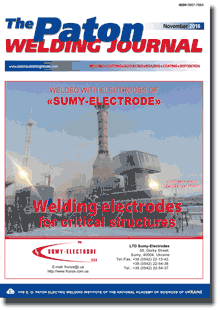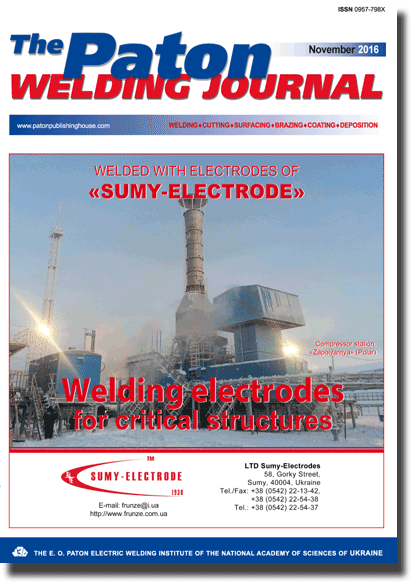| 2016 №11 (02) |
DOI of Article 10.15407/tpwj2016.11.03 |
2016 №11 (04) |

The Paton Welding Journal, 2016, #11, 17-22 pages
Influence of methods of arc surfacing with flux-cored wire on penetration of base metal and formation of deposited metal
A.A. Babinets1, I.A. Ryabtsev1, A.I. Panfilov2, V.A. Zhdanov1 and I.I. Ryabtsev1
1E.O. Paton Electric Welding Institute, NASU 11 Kazimir Malevich Str., 03680, Kiev, Ukraine. E-mail: office@paton.kiev.ua
2OJSC «Steel Work» 13 Tbilisskaya Str. 50005, Krivoy Rog, Ukraine
Abstract
The influence of methods of automatic arc surfacing on penetration of base metal, quality of formation and geometric sizes of deposited beads was investigated. In the experiments nine batches of flux-cored wires (25Kh5FMS type of deposited metal) of the diameter of 1.8; 2.4 and 2.8 mm for submerged arc, shielding gas and open arc surfacing were used. The surfacing was carried out in a wide range of modes: Is = 150–450 A; Us = 20–34 V at the same surfacing speed of 20 m/h. It was found that the greatest influence on formation of deposited beads is exerted by arc voltage. Moreover, the range of ΔUT voltages, at which a good formation of deposited beads and absence of pores is provided, does not coincide during surfacing by different methods with wire of the same diameter. The results obtained in this work can be used for selecting the method of arc surfacing, surfacing modes, which ultimately meet the operating conditions and the requirements to the deposited metal for definite parts. These results will be also used in databases in the development of computer programs for robotized additive technologies of arc surfacing. 13 Ref., 1 Table, 6 Figures.
Keywords: arc surfacing, surfacing modes, additive technologies of surfacing, flux-cored wire, deposited metal, penetration, formation of deposited metal
Received: 15.09.16
Published: 14.12.16
References
- Pokhodnya, I.K., Suptel, A.M., Shlepakov, V.N. (1972) Flux-cored wire welding. Kiev: Naukova Dumka.
- Pokhodnya, I.K., Yavdoshchin, I.R., Paltsevich, A.P. et al. (1994) Metallurgy of arc welding, interaction of metal with gases. Kiev: Naukova Dumka.
- Pokhodnya, I.K., Shlepakov, V.N., Maksimov, S.Yu. et al. (2010) Research and developments of the E.O. Paton Electric Welding Institute in the field of electric arc welding and surfacing using flux-cored wire (Review). The Paton Welding J., 12, 26–33.
- Yuzvenko, Yu.A., Kirilyuk, G.A. (1973) Flux-cored wire surfacing. Moscow: Mashinostroenie.
- Shlepakov, V.N., Gavrilyuk, Yu.A., Kotelchuk, A.S. (2010) State-of-the-art of development and application of flux-cored wires for welding of carbon and low-alloyed steels. The Paton Welding J., 3, 38–42.
- Shlepakov, V.N. (2014) Physical-metallurgical and welding-technological properties of gas-shielded flux-cored wires in welding of structural steels. Ibid., 6/7, 53–56. https://doi.org/10.15407/tpwj2014.06.10
- Rosert, R. (2014) Application of flux-cored wires for welding under industrial conditions. Ibid., 6/7, 57–61. https://doi.org/10.15407/tpwj2014.06.11
- Kondratiev, I.A., Ryabtsev, I.A. (2014) Flux-cored wires for surfacing of steel rollers for hot rolling. Ibid., 6/7, 95–96. https://doi.org/10.15407/tpwj2014.06.20
- Ryabtsev, I.A. (2004) Surfacing of machine and mechanism parts. Kiev: Ekotekhnologiya.
- Razikov, M.I. (1962) Automatic CO2 surfacing. Moscow: Mashinostroenie.
- Demchenko, V.F., Ryabtsev, I.A., Kozlitina, S.S. (1998) Computer system of design of arc surfacing technologies. Svarka, 11, 61–66.
- Demchenko, V.F., Ryabtsev, I.A., Kozlitina, S.S. (1999) Computer system of design of technologies for restoration and strengthening of metallurgical equipment parts. Tyazholoe Mashinostroenie, 2, 25–26.
- Ryabtsev, I.A., Lankin, Yu.N., Soloviov, V.G. et al. (2015) Computer information-and-measuring system for investigation of arc surfacing processes. The Paton Welding J., 9, 32–35. https://doi.org/10.15407/tpwj2015.09.05
Suggested Citation
A.A. Babinets, I.A. Ryabtsev, A.I. Panfilov, V.A. Zhdanov and I.I. Ryabtsev (2016) Influence of methods of arc surfacing with flux-cored wire on penetration of base metal and formation of deposited metal. The Paton Welding J., 11, 17-22.The cost of subscription/purchase order journals or individual articles
| Journal/Currency | Annual Set | 1 issue printed |
1 issue |
one article |
| TPWJ/USD | 384 $ | 32 $ | 26 $ | 13 $ |
| TPWJ/EUR | 348 € | 29 € | 24 € | 12 € |
| TPWJ/UAH | 7200 UAH | 600 UAH | 600 UAH | 280 UAH |
| AS/UAH | 1800 UAH | 300 UAH | 300 UAH | 150 UAH |
| AS/USD | 192 $ | 32 $ | 26 $ | 13 $ |
| AS/EUR | 180 € | 30 € | 25 € | 12 € |
| SEM/UAH | 1200 UAH | 300 UAH | 300 UAH | 150 UAH |
| SEM/USD | 128 $ | 32 $ | 26 $ | 13 $ |
| SEM/EUR | 120 € | 30 € | 25 € | 12 € |
| TDNK/UAH | 1200 UAH | 300 UAH | 300 UAH | 150 UAH |
| TDNK/USD | 128 $ | 32 $ | 26 $ | 13 $ |
| TDNK/EUR | 120 € | 30 € | 25 € | 15 € |
AS = «Automatic Welding» - 6 issues per year;
TPWJ = «PATON WELDING JOURNAL» - 12 issues per year;
SEM = «Electrometallurgy Today» - 4 issues per year;
TDNK = «Technical Diagnostics and Non-Destructive Testing» - 4 issues per year.


